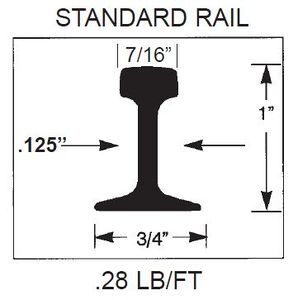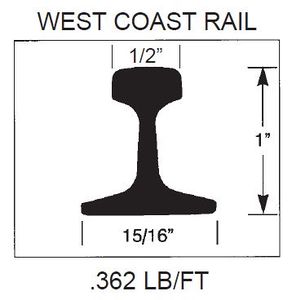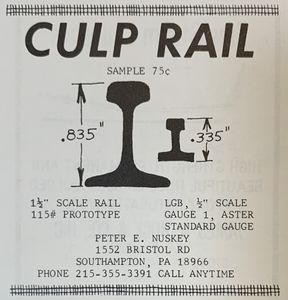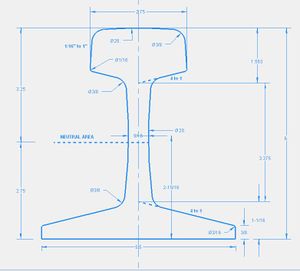IBLS Track Standard: Difference between revisions
(→Grades) |
(changed chaski.com to chaski.org in 2 places) |
||
| (41 intermediate revisions by 2 users not shown) | |||
| Line 1: | Line 1: | ||
[[Category:Standards]] | [[Category:Standards]] | ||
== Gauge == | |||
[[File:Gauge EN.jpg|thumb|center|300px|Correct way to measure gauge]] | [[File:Gauge EN.jpg|thumb|center|300px|Correct way to measure gauge]] | ||
| Line 6: | Line 8: | ||
<tr><td>Scale</td><td>Ratio</td><td>Standard Gauge</td><td>Notes</td></tr> | <tr><td>Scale</td><td>Ratio</td><td>Standard Gauge</td><td>Notes</td></tr> | ||
<tr><td>00</td><td>1:67</td><td>16.5 mm<br>0.650 | <tr><td>00</td><td>1:67</td><td>16.5 mm<br>0.650 inch</td><td>Hornby produced.Generally regarded as the smallest scale for live steam.</td></tr> | ||
<tr><td>O</td><td>1:45</td><td>32 mm<br>1.260 | <tr><td>O</td><td>1:45</td><td>32 mm<br>1.260 inch</td><td>Popularly used for the small scale live steam.</td></tr> | ||
<tr><td>No. 1</td><td>1:32</td><td>45 mm<br>1.772 | <tr><td>No. 1</td><td>1:32</td><td>45 mm<br>1.772 inch</td><td>Popularly used for the small scale live steam. Corresponds to NEM 1 or NMRA #I.</td></tr> | ||
<tr><td>No. 3<br> | <tr><td>No. 3<br>1⁄2 inch</td><td>1:22.6</td><td>63.5 mm<br>2 1⁄2 inch</td><td>The smallest scale able to pull real passengers. Was one of the first popular live steam gauges, developed in England in the early 1900s. In terms of model railway operation, Gauge '3' is the largest (standard gauge) scenic railway modelling scale, using a scale of 13.5mm to the foot. The Gauge '3' Society represents this aspect of 2½ inch gauge railway modelling with both electric and live steam operation. Gauge '3' corresponds to NEM II scale, also known as 'Spur II' in Germany. | ||
The National 2.5 | The National 2.5 inch Association continues to support live steam passenger hauling in 2.5 inch gauge using MES Tracks. They use a 'scale' appropriate to the original prototype modelling both standard and narrow gauge locomotives to run on 2.5 inch track. | ||
</td></tr> | </td></tr> | ||
<tr><td>3/4 | <tr><td>3/4 inch</td><td>1:16</td><td>3 1⁄2 inch<br>89 mm</td><td>A worldwide garden railroad scale. Corresponds to NEM III and NMRA 3/4".</td></tr> | ||
<tr><td>1 inch</td><td>1:12</td><td>4 3⁄4 inch<br>121 mm</td><td>North America specific scale corresponding to NMRA 1" scale. 1:12 is one of the most popular backyard railway scales.</td></tr> | |||
<tr><td>1 inch</td><td>1:11</td><td>5 inch<br>127 mm</td><td>Used outside North America. Corresponds to NEM V. One of the most popular garden railway scales.</td></tr> | |||
<tr><td>1.5 inch</td><td>1:8</td><td>7 1⁄4 inch<br>184 mm</td><td>Used in North-Eastern USA, Canada and the world outside North America. Corresponds to NEM VII.</td></tr> | |||
<tr><td>1.5 inch</td><td>1:8</td><td>7 1⁄2 inch<br>190.5 mm</td><td>Used in North America outside of New England and Eastern Canada.</td></tr> | |||
<tr><td>1.6 inch</td><td>1:7.5</td><td>7 1⁄4, 7 1⁄2 inch<br>190.5 mm</td><td>1.6in=1ft. Used in the USA, often finer-scale.</td></tr> | |||
<tr><td> | <tr><td>2 inch</td><td>1:6</td><td>7 1⁄4, 7 1⁄2, 9, 10, 12, 14 inch<br></td><td>Narrow gauge for 7 1⁄4 and 7 1⁄2 inch gauge.</td></tr> | ||
<tr><td> | <tr><td>2.5 inch</td><td>1:5</td><td>7 1⁄4, 7 1⁄2, 9, 10, 12, 14, 15 inch<br></td><td>Narrow gauge for 7 1⁄4 and 7 1⁄2 inch gauge.</td></tr> | ||
<tr><td> | <tr><td>3 inch</td><td>1:4</td><td>12, 14, 15 inch<br></td><td></td></tr> | ||
<tr><td> | <tr><td>3.75 inch</td><td>1:3.125</td><td>7 1⁄4, 7 1⁄2 inch<br></td><td>Narrow gauge for 7 1⁄4 and 7 1⁄2 inch gauge.</td></tr> | ||
<tr><td> | <tr><td>4 inch</td><td>1:3</td><td>15, 16 inch<br></td><td></td></tr> | ||
<tr><td>5 inch</td><td>1:2.4</td><td>15, 16, 18 inch<br></td><td></td></tr> | |||
<tr><td>6 inch</td><td>1:2</td><td>18 inch<br></td><td></td></tr> | |||
</table> | </table> | ||
Special thanks to Glenn Brooks, who provided information for 2 inch scale and above. | |||
== Rail Gap == | |||
See [[Rail expansion]]. | |||
== Background == | == Background == | ||
| Line 40: | Line 62: | ||
In the Western U.S. the gauge for 1 1/2" scale is 7 1/2 inch gauge. In the Eastern U.S. the gauge for this same scale is 7 1/4 inches. The same in Canada. Neither gauge is truly correct for the scale involved. For the absolute "purist", the gauge for 1 1/2 inch scale works out to 7 1/16 inches. | In the Western U.S. the gauge for 1 1/2" scale is 7 1/2 inch gauge. In the Eastern U.S. the gauge for this same scale is 7 1/4 inches. The same in Canada. Neither gauge is truly correct for the scale involved. For the absolute "purist", the gauge for 1 1/2 inch scale works out to 7 1/16 inches. | ||
This is really a shame because Live Steamers in different parts of the country are "restricted" on whose tracks they can visit and run on. Many years ago, one of the older GGLS members in Oakland, CA built an absolute stunning model of a STEAM locomotive as well as a Steeple-cab locomotive that drew power from either Overhead wire or outside 3rd rail (a 'la SN) and a large beautifully constructed wood caboose. His name was Louis Lawrence and he resided in West Oakland. However. he could ONLY operate his beautiful creations in his own backyard. Why ?? Because for some strange reason he built them with a track gauge of 6 3/8 inches. | This is really a shame because Live Steamers in different parts of the country are "restricted" on whose tracks they can visit and run on. Many years ago, one of the older GGLS members in Oakland, CA built an absolute stunning model of a STEAM locomotive as well as a Steeple-cab locomotive that drew power from either Overhead wire or outside 3rd rail (a 'la SN) and a large beautifully constructed wood caboose. His name was [[Louis Lawrence]] and he resided in West Oakland. However. he could ONLY operate his beautiful creations in his own backyard. Why ?? Because for some strange reason he built them with a track gauge of 6 3/8 inches. | ||
The track gauge on Erich Thomsen's "Redwood Valley Railroad" was originally 12 inches before he enlarged it to the current 15 inches. | The track gauge on Erich Thomsen's "Redwood Valley Railroad" was originally 12 inches before he enlarged it to the current 15 inches. | ||
| Line 57: | Line 79: | ||
This is a survey of historic and existing rail form factors and their suppliers. If you have data to contribute to this survey please contact [mailto:daris@nevil.org Daris Nevil]. | This is a survey of historic and existing rail form factors and their suppliers. If you have data to contribute to this survey please contact [mailto:daris@nevil.org Daris Nevil]. | ||
* Buddy-L Rail | * [[Buddy-L]] Rail | ||
** For 3/4 | ** For 3/4 inch scale - 5/8 inch high - steel, rolled by Bethlehem Steel Co | ||
* [http://www.cannonballltd.com/rail_cat.html Cannonball Rail] | * [http://www.cannonballltd.com/rail_cat.html Cannonball Rail] | ||
** For 1-1/2 | ** For 1-1/2 inch scale - "Standard" - 1 inch high, 7/16 inch wide head, 1/8 inch wide web, 3/4 inch wide foot, length 10 foot, aluminum | ||
** For 1-1/2 | ** For 1-1/2 inch scale - "West Coast" - 1 inch high, 1/2 inch wide head, 15/16 inch wide foot, length 10 foot, aluminum | ||
<gallery widths=300px heights=300px perrow=2> | |||
File:CannonballLtd StandardRail 2004.JPG|[[Cannonball Ltd]] "Standard" aluminum rail profile, from their 2004 catalog. | |||
File:CannonballLtd WestCoastRail 2004.JPG|[[Cannonball Ltd]] "West Coast" aluminum rail profile, from their 2004 catalog. | |||
</gallery> | |||
* Culp Rail | * Culp Rail | ||
** Peter Nuskey, a machinist in Pennsylvania, has been offering Culp Rail (a 1/8 scale aluminum model of Pennsylvania Railroad’s 115lb steel rail) for over 40 years, as of 2012. | ** Peter Nuskey, a machinist in Pennsylvania, has been offering Culp Rail (a 1/8 scale aluminum model of Pennsylvania Railroad’s 115lb steel rail) for over 40 years, as of 2012. | ||
** 1-1/ | ** 1-1/2 inch scale rail 0.825 inch high – 10 foot lengths – 6061T6 Aluminum | ||
** 3/ | ** 3/4 inch scale rail 0.625 inch high – 10 foot lengths | ||
** LGB rail 0. | ** LGB rail 0.335 inch high – 10 foot lengths | ||
<gallery widths=300px heights=300px perrow=2> | |||
File:CulpRail LiveSteam Feb1981.jpg|Culp Rail advertisement from Live Steam Magazine, February 1981. | |||
</gallery> | |||
* [http://www.friendsmodels.com/productsforsale/rail.html Friends "Yankee Shop" Rail] | * [http://www.friendsmodels.com/productsforsale/rail.html Friends "Yankee Shop" Rail] | ||
** For 3/4 | ** For 3/4 inch scale and 5 inch scale - 5/8 inch high - 10 foot lengths - aluminum | ||
* [[Groovy Track]] | * [[Groovy Track]] | ||
** 1-1/2 | ** 1-1/2 inch scale - 1 inch x 3/8 inch [[HRS]] flat | ||
** See also [http://www.discoverlivesteam.com/magazine/168/index.htm "No Weld Groovy Track", DiscoverLiveSteam.com] | ** See also [http://www.discoverlivesteam.com/magazine/168/index.htm "No Weld Groovy Track", DiscoverLiveSteam.com] | ||
* L S Rail | * L S Rail | ||
** Aluminum 6063-T5, 1.5 Scale LS Rail, | ** Aluminum 6063-T5, 1.5 Scale LS Rail, 10 foot lengths | ||
* [http://www.livesteamlocomotives.com/ Live Steam Locomotives] | * [http://www.livesteamlocomotives.com/ Live Steam Locomotives] | ||
** 1 | ** 1 inch high by 1/2 inch wide, 15/16 inch foot - aluminum | ||
* [http://www.realtrains.com/ | * [http://www.realtrains.com/files/83950654.pdf Real Trains] | ||
** For 1 | ** For 1 inch scale - 0.500 inch high, 0.234 inch wide head, 0.457 inch wide foot - 6061T6 Aluminum | ||
** For 1-1/2 | ** For 1-1/2 inch scale - 0.891 inch high, 0.369 inch wide head, 0.750 inch wide foot - 6061T6 Aluminum | ||
** For 3" scale - 1.500 | ** For 3" scale - 1.500 inch high, 0.600 inch wide head, 1.200 inch wide foot - 6061T6 Aluminum | ||
* [http://www.rmirailworks.com/ RMI Railworks] | * [http://www.rmirailworks.com/ RMI Railworks] | ||
** For 1-1/2 | ** For 1-1/2 inch scale - 1 inch high - 6061T6 aluminum and steel | ||
* West Coast | * West Coast | ||
** 1 | ** 1 inch high, 1/2 inch wide head, 15/16 inch wide foot | ||
* George Pruitt's "[http://ibls.org/mediawiki/index.php?title=Sagebrush_Short_Line_Railroad#Groovy_Rail Groovy Rail]" | * George Pruitt's "[http://ibls.org/mediawiki/index.php?title=Sagebrush_Short_Line_Railroad#Groovy_Rail Groovy Rail]" | ||
** Does not require fasteners | ** Does not require fasteners | ||
* [[Conical Tool Company]] | |||
** 0.634 high, 5/16 inch wide head, 3/8 inch wide foot | |||
* [[Live Steamer Parts LLC]] | |||
** For 1 inch scale - 5/8 inch tall 5/8 inch foot, with 1/4 inch railhead, 8-1/2 foot lengths | |||
* [[Portable track]] | |||
* Grand Scale Rail | |||
: Glenn Brooks wrote: | |||
:: Regarding rail, over the past 100 years, 8# (8 pound) rail was common during the early 1900’s, but has largely been replaced with 12# rail. Nowadays 6 kg rail (13.2#) is the most prevalent size rail produced by rail suppliers. | |||
== Tie Spacing == | |||
See Also: | |||
* [[Texas Standard Tie Spacing]] | |||
* [[Charles Field Track Panel Jig]] | |||
== Rail Profiles == | == Rail Profiles == | ||
| Line 115: | Line 160: | ||
== Turnouts == | == Turnouts == | ||
* [[Turnouts]] | |||
* [http://www.southerncalifornialivesteamers.com/SCLS_Live_Steam_Railroad_Frog_Standards.asp SCLS Frog Standards] | * [http://www.southerncalifornialivesteamers.com/SCLS_Live_Steam_Railroad_Frog_Standards.asp SCLS Frog Standards] | ||
* [http://csme-eprr.com/eprr/track/EPRR-TrackWork.htm Eagle Point RR Track Work] | * [http://csme-eprr.com/eprr/track/EPRR-TrackWork.htm Eagle Point RR Track Work] | ||
| Line 132: | Line 178: | ||
* 1-1/2 percent on a 40 foot radius | * 1-1/2 percent on a 40 foot radius | ||
== Elevated | == Elevated Track == | ||
See [[Track | See [[Elevated Track]]. | ||
== Bibliography == | == Bibliography == | ||
| Line 142: | Line 188: | ||
== References == | == References == | ||
* [http://en.wikipedia.org/wiki/Track_%28rail_transport%29 Track | * [http://en.wikipedia.org/wiki/Track_%28rail_transport%29 "Track", <i>Wikipedia</i>] | ||
* [http://www.icrr.net/rails.htm Rail Specifications | * [https://en.wikipedia.org/wiki/Rail_profile "Rail Profile", <i>Wikipedia</i>] | ||
* [http://www.icrr.net/rails.htm Rail Specifications, <i>American Society of Civil Engineers (A.S.C.E.)</i>] | |||
* [http://www.icrr.net/rails.htm ASCE Rail Information] | * [http://www.icrr.net/rails.htm ASCE Rail Information] | ||
* [http://www.grandscales.com/freestuff/Track%20Manual.pdf Swanton Pacific Railroad Track Manual] | * [http://www.grandscales.com/freestuff/Track%20Manual.pdf Swanton Pacific Railroad Track Manual] | ||
* [http://www.chaski. | * [http://www.chaski.org/homemachinist/viewtopic.php?f=8&t=91413 Chaski.org, thread on 3/4" scale rail] | ||
* [http://www.chaski. | * [http://www.chaski.org/homemachinist/viewtopic.php?f=8&t=81579 Chaski.org, info on Peter Nuskey] | ||
* [http://www.black5video.com/wordpress/why-build-a-backyard-railroad/ "Mill Brook Railroad", info on Culp Rail/Peter Nuskey] | * [http://www.black5video.com/wordpress/why-build-a-backyard-railroad/ "Mill Brook Railroad", info on Culp Rail/Peter Nuskey] | ||
* [http://www.steamingpriest.com/suppliers/rail/ "Live Steam by Father Finelli", info on Culp Rail and L S Rail] | * [http://www.steamingpriest.com/suppliers/rail/ "Live Steam by Father Finelli", info on Culp Rail and L S Rail] | ||
| Line 153: | Line 200: | ||
* [http://en.wikipedia.org/wiki/Ridable_miniature_railway "Ridable miniature railway", <i>Wikipedia</i>, provides an extensive list of gauges from around the world] | * [http://en.wikipedia.org/wiki/Ridable_miniature_railway "Ridable miniature railway", <i>Wikipedia</i>, provides an extensive list of gauges from around the world] | ||
* [http://www.grandscales.com/freestuff/Track%20Manual.pdf Swanton Pacific Railroad Track Manual] | * [http://www.grandscales.com/freestuff/Track%20Manual.pdf Swanton Pacific Railroad Track Manual] | ||
* [http://www.calvertcentral.com/LiveSteam_1.html "Assembling Track Panels", <i>Calvert Centrail RR</i>] | |||
* [http://www.discoverlivesteam.com/discoverforsale/forsale/1_fallon/index.htm Dimensions for 8 and 12 pound rail, <i>DiscoverLiveSteam.com</i>] | |||
* [http://www.chaski.org/homemachinist/viewtopic.php?f=33&t=101053 "Typical rail loading weights", <i>Chaski.org</i>] | |||
* [http://www.chaski.org/homemachinist/viewtopic.php?f=8&t=101029 "Radius of curve", <i>Chaski.org</i>] | |||
* [http://harmersteel.com/catalog/tee-rails/ Specifications and Drawings for rail, 12-lb/yd and up, <i>Harmer Steel Co</i>] | |||
* "Rail Gap Standards", Arthur W. Reiter, <i>[[Modeltec]]</i>, January 1994 | |||
* [https://www.jghtech.com/assets/applets/LFLSRM-Fundamentals-of-Railway-Curve-Superelevation-current.pdf "Fundamentals of Railway Curve Superelevation", Jeffrey G. Hook, <i>Deerfield & Roundabout RR</i>] | |||
* [http://www.harmersteel.com/tee-rails/12-lb-yd-asce-rail/ Prototype rail drawings and specification, <i>Harmer Steel</i>] | |||
* [https://www.chaski.org/homemachinist/viewtopic.php?f=8&t=104115&p=361213&hilit=tie+track+spacing#p361089 "Typical Tie Spacing 7-1/X Gauge?", <i>Chaski.org</i>] | |||
Revision as of 12:22, 10 May 2021
Gauge
| Scale | Ratio | Standard Gauge | Notes |
| 00 | 1:67 | 16.5 mm 0.650 inch | Hornby produced.Generally regarded as the smallest scale for live steam. |
| O | 1:45 | 32 mm 1.260 inch | Popularly used for the small scale live steam. |
| No. 1 | 1:32 | 45 mm 1.772 inch | Popularly used for the small scale live steam. Corresponds to NEM 1 or NMRA #I. |
| No. 3 1⁄2 inch | 1:22.6 | 63.5 mm 2 1⁄2 inch | The smallest scale able to pull real passengers. Was one of the first popular live steam gauges, developed in England in the early 1900s. In terms of model railway operation, Gauge '3' is the largest (standard gauge) scenic railway modelling scale, using a scale of 13.5mm to the foot. The Gauge '3' Society represents this aspect of 2½ inch gauge railway modelling with both electric and live steam operation. Gauge '3' corresponds to NEM II scale, also known as 'Spur II' in Germany.
The National 2.5 inch Association continues to support live steam passenger hauling in 2.5 inch gauge using MES Tracks. They use a 'scale' appropriate to the original prototype modelling both standard and narrow gauge locomotives to run on 2.5 inch track. |
| 3/4 inch | 1:16 | 3 1⁄2 inch 89 mm | A worldwide garden railroad scale. Corresponds to NEM III and NMRA 3/4". |
| 1 inch | 1:12 | 4 3⁄4 inch 121 mm | North America specific scale corresponding to NMRA 1" scale. 1:12 is one of the most popular backyard railway scales. |
| 1 inch | 1:11 | 5 inch 127 mm | Used outside North America. Corresponds to NEM V. One of the most popular garden railway scales. |
| 1.5 inch | 1:8 | 7 1⁄4 inch 184 mm | Used in North-Eastern USA, Canada and the world outside North America. Corresponds to NEM VII. |
| 1.5 inch | 1:8 | 7 1⁄2 inch 190.5 mm | Used in North America outside of New England and Eastern Canada. |
| 1.6 inch | 1:7.5 | 7 1⁄4, 7 1⁄2 inch 190.5 mm | 1.6in=1ft. Used in the USA, often finer-scale. |
| 2 inch | 1:6 | 7 1⁄4, 7 1⁄2, 9, 10, 12, 14 inch | Narrow gauge for 7 1⁄4 and 7 1⁄2 inch gauge. |
| 2.5 inch | 1:5 | 7 1⁄4, 7 1⁄2, 9, 10, 12, 14, 15 inch | Narrow gauge for 7 1⁄4 and 7 1⁄2 inch gauge. |
| 3 inch | 1:4 | 12, 14, 15 inch | |
| 3.75 inch | 1:3.125 | 7 1⁄4, 7 1⁄2 inch | Narrow gauge for 7 1⁄4 and 7 1⁄2 inch gauge. |
| 4 inch | 1:3 | 15, 16 inch | |
| 5 inch | 1:2.4 | 15, 16, 18 inch | |
| 6 inch | 1:2 | 18 inch |
Special thanks to Glenn Brooks, who provided information for 2 inch scale and above.
Rail Gap
See Rail expansion.
Background
From http://www.trainorders.com/discussion/read.php?3,2249399
Date: 08/08/10 08:05
Many thanks to Mike ONeill of Parker, CO for providing some general info on Live Steam track gauges. In the United States and Canada, no one could ever come together and "standardize" on what certain scale gauges should really be, which was unfortunate. Some examples: The standard gauges as adopted by the NMRA years ago for the small live steam railroads are--- 2 1/2 inch (1/2" scale); 3 1/2 inch (3/4" scale), and 4 3/4 inch (1" scale)... In the UK and Canada, 5 inch gauge represents 1" scale...
In the Western U.S. the gauge for 1 1/2" scale is 7 1/2 inch gauge. In the Eastern U.S. the gauge for this same scale is 7 1/4 inches. The same in Canada. Neither gauge is truly correct for the scale involved. For the absolute "purist", the gauge for 1 1/2 inch scale works out to 7 1/16 inches.
This is really a shame because Live Steamers in different parts of the country are "restricted" on whose tracks they can visit and run on. Many years ago, one of the older GGLS members in Oakland, CA built an absolute stunning model of a STEAM locomotive as well as a Steeple-cab locomotive that drew power from either Overhead wire or outside 3rd rail (a 'la SN) and a large beautifully constructed wood caboose. His name was Louis Lawrence and he resided in West Oakland. However. he could ONLY operate his beautiful creations in his own backyard. Why ?? Because for some strange reason he built them with a track gauge of 6 3/8 inches.
The track gauge on Erich Thomsen's "Redwood Valley Railroad" was originally 12 inches before he enlarged it to the current 15 inches.
Anyway, even with early-day intervention by some of the IBLS secretaries, the gauge drama still lingers on. If you are a Live Steam hobbyist, you RUN where you can.
- Cheers.
- KEN SHATTOCK
- Secretary
- North American Region
- International Brotherhood of Live Steamers
Model Rail Types
This is a survey of historic and existing rail form factors and their suppliers. If you have data to contribute to this survey please contact Daris Nevil.
- Buddy-L Rail
- For 3/4 inch scale - 5/8 inch high - steel, rolled by Bethlehem Steel Co
- Cannonball Rail
- For 1-1/2 inch scale - "Standard" - 1 inch high, 7/16 inch wide head, 1/8 inch wide web, 3/4 inch wide foot, length 10 foot, aluminum
- For 1-1/2 inch scale - "West Coast" - 1 inch high, 1/2 inch wide head, 15/16 inch wide foot, length 10 foot, aluminum
Cannonball Ltd "Standard" aluminum rail profile, from their 2004 catalog.
Cannonball Ltd "West Coast" aluminum rail profile, from their 2004 catalog.
- Culp Rail
- Peter Nuskey, a machinist in Pennsylvania, has been offering Culp Rail (a 1/8 scale aluminum model of Pennsylvania Railroad’s 115lb steel rail) for over 40 years, as of 2012.
- 1-1/2 inch scale rail 0.825 inch high – 10 foot lengths – 6061T6 Aluminum
- 3/4 inch scale rail 0.625 inch high – 10 foot lengths
- LGB rail 0.335 inch high – 10 foot lengths
- Friends "Yankee Shop" Rail
- For 3/4 inch scale and 5 inch scale - 5/8 inch high - 10 foot lengths - aluminum
- Groovy Track
- 1-1/2 inch scale - 1 inch x 3/8 inch HRS flat
- See also "No Weld Groovy Track", DiscoverLiveSteam.com
- L S Rail
- Aluminum 6063-T5, 1.5 Scale LS Rail, 10 foot lengths
- Live Steam Locomotives
- 1 inch high by 1/2 inch wide, 15/16 inch foot - aluminum
- Real Trains
- For 1 inch scale - 0.500 inch high, 0.234 inch wide head, 0.457 inch wide foot - 6061T6 Aluminum
- For 1-1/2 inch scale - 0.891 inch high, 0.369 inch wide head, 0.750 inch wide foot - 6061T6 Aluminum
- For 3" scale - 1.500 inch high, 0.600 inch wide head, 1.200 inch wide foot - 6061T6 Aluminum
- RMI Railworks
- For 1-1/2 inch scale - 1 inch high - 6061T6 aluminum and steel
- West Coast
- 1 inch high, 1/2 inch wide head, 15/16 inch wide foot
- George Pruitt's "Groovy Rail"
- Does not require fasteners
- Conical Tool Company
- 0.634 high, 5/16 inch wide head, 3/8 inch wide foot
- Live Steamer Parts LLC
- For 1 inch scale - 5/8 inch tall 5/8 inch foot, with 1/4 inch railhead, 8-1/2 foot lengths
- Grand Scale Rail
- Glenn Brooks wrote:
- Regarding rail, over the past 100 years, 8# (8 pound) rail was common during the early 1900’s, but has largely been replaced with 12# rail. Nowadays 6 kg rail (13.2#) is the most prevalent size rail produced by rail suppliers.
Tie Spacing
See Also:
Rail Profiles
Supplementary Information
- Railroad Track Maintenance and Saftey Standards - DOD 2008 (PDF)
- Maintenance of Trackage, DOD 1980 (PDF)
- Mill Creek Central RR Track Building & Track Laying Standards
Turnouts
Grades
From Large-scale Model Railroading, page 52:
- On curves, there is more resistance or drag to the train. For this reason, grades should be reduced when a curve is involed. Using prototype figures as a guideline, we find that our grades should be reduced as follows:
- 1/2 percent on a 125 foot radius
- 3/4 percent on a 75 foot radius
- 1 percent on a 60 foot radius
- 1-1/4 percent on a 50 foot radius
- 1-1/2 percent on a 40 foot radius
Elevated Track
See Elevated Track.
Bibliography
- "Mini-Rail News - Track Standards", Lewis Soibelman, Live Steam Magazine, Mar 1991
References
- "Track", Wikipedia
- "Rail Profile", Wikipedia
- Rail Specifications, American Society of Civil Engineers (A.S.C.E.)
- ASCE Rail Information
- Swanton Pacific Railroad Track Manual
- Chaski.org, thread on 3/4" scale rail
- Chaski.org, info on Peter Nuskey
- "Mill Brook Railroad", info on Culp Rail/Peter Nuskey
- "Live Steam by Father Finelli", info on Culp Rail and L S Rail
- Mini-Rail Corporation
- "Ridable miniature railway", Wikipedia, provides an extensive list of gauges from around the world
- Swanton Pacific Railroad Track Manual
- "Assembling Track Panels", Calvert Centrail RR
- Dimensions for 8 and 12 pound rail, DiscoverLiveSteam.com
- "Typical rail loading weights", Chaski.org
- "Radius of curve", Chaski.org
- Specifications and Drawings for rail, 12-lb/yd and up, Harmer Steel Co
- "Rail Gap Standards", Arthur W. Reiter, Modeltec, January 1994
- "Fundamentals of Railway Curve Superelevation", Jeffrey G. Hook, Deerfield & Roundabout RR
- Prototype rail drawings and specification, Harmer Steel
- "Typical Tie Spacing 7-1/X Gauge?", Chaski.org




